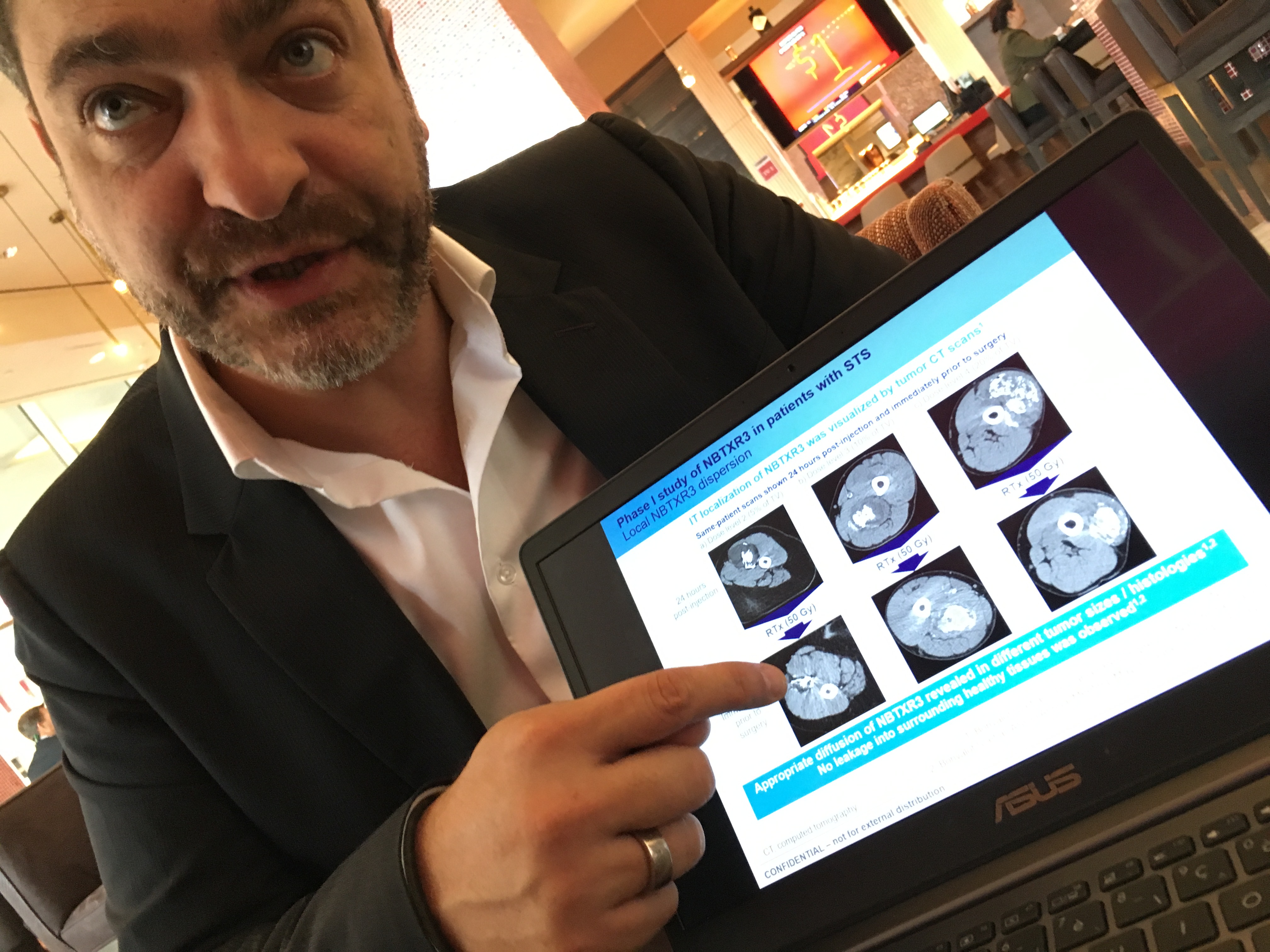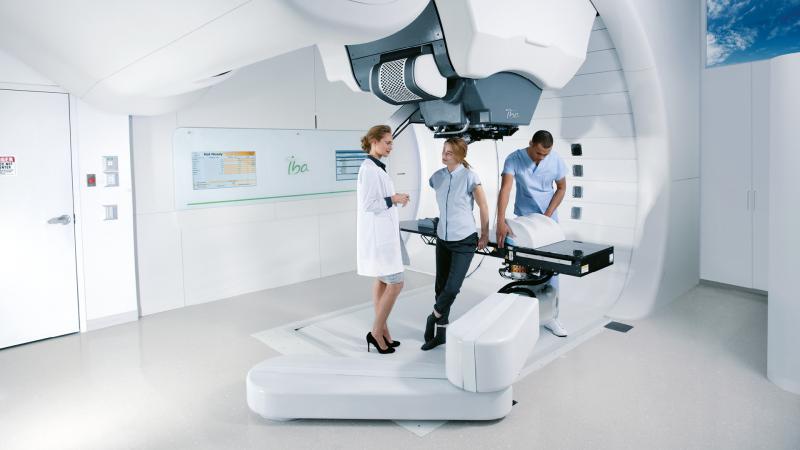
Laurent Levy, CEO of Nanobiotix, explains the use of his company’s nanoparticles to enhance the radiation sensitivity of tumor tissue to improve patient outcomes. The metallic-based nanoparticles show up on CT scans so it can be used as a permanent fiduciary marker to track tumor response. The images show the initial tumor and enhancement areas due to the nanoparticles and the resulting outcomes following treatment. Photo by Dave Fornell
Artificial intelligence (AI) has been the hot topic discussed at all trade shows, and the 2018 American Society for Radiation Oncology (ASTRO) annual meeting was no exception.
ASTRO also had numerous sessions on the application of AI and how it may aid several areas for research and speeding workflow. Sessions included discussion for deep learning applications in treatment planning, clinical decision support, automated image-guided adaptive radiation therapy and how it can aid in genomic/radio-biologic data mining. AI is being developed to help automate treatment planning software and cut the time it takes to develop plans from hours or days, down to minutes.
In early 2018, Mirada Medical received U.S. Food and Drug Administration (FDA) 510(k) clearance for the world’s first AI-powered auto-contouring solution. The DLCExpert software is used for automatic contouring of computed tomography (CT) scans based on next-generation deep learning contouring (DLC) and is now in use in multiple academic medical centers worldwide. The vendor highlighted this technology at ASTRO 2018.
Improving Radiosensitivity
Radiation oncology has largely had a one-size-fits-all mentality in treating patients, but healthy cells and cancerous tumor cells can greatly vary in sensitivity and response to radiation therapy. ASTRO had numerous sessions on research efforts to better tailor therapies to each patient to cause less collateral damage to health tissues and more damage to cancer. This includes the use of radiomics (the study of small radiology image features to find commonalities to better risk stratify patients), genomics (the study of the genetic profiles for both patients and cancer cells) and liquid biopsy blood tests that capture circulating tumor cells to eliminate biopsies.
In sessions, there also was discussion on the possible use of nanoparticles to enhance radiation sensitivity of tumors, allowing each fraction to cause more damage.
MRI-guided Radiation Therapy
The ViewRay MRIdian is currently the only FDA-cleared magnetic resonance imaging (MRI)-guided radiation therapy system on the U.S. market, but there were two more companies with systems pending FDA review at ASTRO 2018. MRI offers excellent soft tissue detail and allows direct visualization of tumors, including real-time tracking of tumor movement to ensure the beam stays on target. Tissue response can also be viewed with the onboard MRI.
The Elekta Unity system will likely become the second FDA-cleared system. It is currently pending FDA 510(k) approval. It was the centerpiece of the Elekta booth at ASTRO. It gained European CE mark in 2018 and is being reviewed by the FDA. It uses a Philips 1.5T MRI system, which is a standard magnet strength in general radiology MRI systems. It should offer higher image quality than the ViewRay system, which uses a 0.3T imaging system.
The MagnetTx Aurora MRI-guided radiation therapy system was also shown at ASTRO 2018. This startup company submitted for FDA 510(k) review this fall. The company has been developing the system over the past decade. It uses a unique cryogen-free 0.5T MRI system, so there is no need for a vent stack. It also offers a large 110 cm bore, allowing room for the patient table to be moved to align the iso-center of tumors with the linac beam.
Novel PET-guided Radiation Therapy
Displayed for the first time at ASTRO was RefleXion Medical’s biology-guided radiotherapy (BgRT). It uses a novel positron emission tomography/computed tomography (PET-CT) system combined with a Linac in a single gantry that offers a new approach to real-time adaptive therapy.
It is the first system to utilize the cancer itself to guide radiation delivery, even in tumors that are moving. The system uses positron emission tomography (PET) to track the radioactive tracer uptake in cancer cells to lock onto the tumors and eliminate or reduce the need for margins to account for motion. The PET system triangulates the location of the radiotracer for accurate, 3-D, real-time tumor tracking. The RefleXion system also has the ability to track and treat several sites at the same time.
Trends in Proton Therapy Systems
The key messages at ASTRO regarding proton therapy systems were that these are getting smaller, pencil beam therapy will likely become the standard of care in the coming years, and two new treatment methods may significantly cut treatment times and improve outcomes.
Varian and IBA showed new concepts with their systems to speed treatment delivery. Varian announced at ASTRO it is working on a way to deliver a single fraction, one second, very high dose of protons to a tumor to enable a one day, one-and-done session called Flash therapy. The vendor said its newer cyclotron has the capability of delivering much higher proton dose rates than previous generation systems, enabling it to deliver ultra-high dose rates of 40-120 Gy per second.
IBA announced at ASTRO that the first patients have been treated using a Spot Scanning Proton Arc (SPArc) plan at the Beaumont Health Proton Therapy Center in Royal Oak, Mich. Instead of using a traditional series of beams that intersect a tumor and require the gantry or patient to be rotated for each beam, proton arc therapy leaves the beam on as it rotates around the patient, enabling much shorter therapy delivery times.
Tumor Tracking Imaging Using PET-CT
GE Healthcare showed an interesting new imaging technology that allows 4-D visualization of tumor movement during respiration on PET-CT called MotionFree. The technology now available on GE’s PET-CT scanners reduces blur caused by respiratory motion to make nuclear images much clearer. This can aid in identification of smaller tumors that otherwise would have been missed with conventional PET imaging. The MotionFree software also automatically detects and eliminates motion blur on PET scans and enhances 4-D visualization. The correction algorithm improves overall PET image clarity, making the scans look more like CT images.
Related ASTRO content:
VIDEO: Editor's Choice of the Most Innovative Radiation Oncology Tech at ASTRO 2018
Technology Report: Patient-centered Care in Radiation Therapy
itnTV "Conversations": The Accuray Philosophy
VIDEO: Improving Breast Cancer Surgery With Electronic Brachytherapy
VIDEO: Use of Liquid Biopsies to Assess Radiotherapy Response



 December 04, 2025
December 04, 2025 









